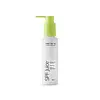What's inside
What's inside
 Key Ingredients
Key Ingredients

 Benefits
Benefits

 Concerns
Concerns

 Ingredients Side-by-side
Ingredients Side-by-side

Water
Skin ConditioningEthylhexyl Methoxycinnamate
UV AbsorberMethylene Bis-Benzotriazolyl Tetramethylbutylphenol
UV FilterEthylhexyl Triazone
UV AbsorberDiethylamino Hydroxybenzoyl Hexyl Benzoate
UV FilterBenzophenone-3
UV AbsorberButyl Methoxydibenzoylmethane
UV AbsorberOryza Sativa Extract
AbsorbentPEG-40 Hydrogenated Castor Oil/Ipdi Copolymer
Skin ConditioningCeramide AP
Skin ConditioningPanax Ginseng Root Extract
EmollientBetula Alba Juice
AstringentHexapeptide-1
Skin ConditioningCentella Asiatica Extract
CleansingPhenoxyethanol
PreservativeNiacinamide
SmoothingBakuchiol
AntimicrobialHyaluronic Acid
HumectantPanthenol
Skin ConditioningSqualane
EmollientCamellia Sinensis Leaf Extract
AntimicrobialDipotassium Glycyrrhizate
HumectantTocopherol
AntioxidantWater, Ethylhexyl Methoxycinnamate, Methylene Bis-Benzotriazolyl Tetramethylbutylphenol, Ethylhexyl Triazone, Diethylamino Hydroxybenzoyl Hexyl Benzoate, Benzophenone-3, Butyl Methoxydibenzoylmethane, Oryza Sativa Extract, PEG-40 Hydrogenated Castor Oil/Ipdi Copolymer, Ceramide AP, Panax Ginseng Root Extract, Betula Alba Juice, Hexapeptide-1, Centella Asiatica Extract, Phenoxyethanol, Niacinamide, Bakuchiol, Hyaluronic Acid, Panthenol, Squalane, Camellia Sinensis Leaf Extract, Dipotassium Glycyrrhizate, Tocopherol
Water
Skin ConditioningEthylhexyl Methoxycinnamate
UV AbsorberButyl Methoxydibenzoylmethane
UV AbsorberBenzophenone-3
UV AbsorberPhospholipids
Skin ConditioningButylene Glycol
HumectantTitanium Dioxide
Cosmetic ColorantHydrated Silica
AbrasiveHydrogen Dimethicone
PEG-9 Dimethicone
Skin ConditioningGlycerin
HumectantC13-15 Alkane
SolventHeptyl Undecylenate
EmollientSodium Acrylate/Sodium Acryloyldimethyl Taurate Copolymer
Emulsion StabilisingHydroxypropyl Starch Phosphate
Phenoxyethanol
PreservativeEthylhexylglycerin
Skin ConditioningSodium Gluconate
Skin ConditioningWater, Ethylhexyl Methoxycinnamate, Butyl Methoxydibenzoylmethane, Benzophenone-3, Phospholipids, Butylene Glycol, Titanium Dioxide, Hydrated Silica, Hydrogen Dimethicone, PEG-9 Dimethicone, Glycerin, C13-15 Alkane, Heptyl Undecylenate, Sodium Acrylate/Sodium Acryloyldimethyl Taurate Copolymer, Hydroxypropyl Starch Phosphate, Phenoxyethanol, Ethylhexylglycerin, Sodium Gluconate
Ingredients Explained
These ingredients are found in both products.
Ingredients higher up in an ingredient list are typically present in a larger amount.
You probably know this ingredient as Oxybenzone, a sunscreen ingredient. It is a broad-spectrum sunscreen ingredient, meaning it can protect the skin against UVB and short UVA rays. The absorption range is 270-350 nm with peak absorption at 288 and 350 nm.
This chemical ingredient protects your skin by using chemical reactions to convert UV rays into heat and energy. UV absorbers may absorb both UVA and UVB rays. It is often combined with other sunscreen ingredients to help with stability.
Ongoing research is looking into whether oxybenzone causes skin irritation and sensitivity. However, it has been shown to trigger contact dermatitis in some studies.
Oxybenzone is allowed in certain concentrations by many countries. It is allowed up to 6% in the US, and Canada, 5% in Japan, and 10% in Australia. Other countries and regions of the US have banned this ingredient to protect coral reefs and marine ecosystems. These places include Hawaii, Key West, US Virgin Islands, marine parks in Thailand, Aruba, and Palau.
The EU currently allows the following maximum concentrations:
Studies show conflicting results about oxybenzone being absorbed into the human body. The Swedish Research Institute has advised careful use of this ingredient by pregnant women and children. We always recommend speaking with a professional if you have concerns about this ingredient and your health.
Learn more about Benzophenone-3Also known as Avobenzone, this ingredient is a chemical sunscreen filter that provides protection in the UV-A range.
Avobenzone is globally approved and is the most commonly used UV-A filter in the world.
Studies have found that avobenzone becomes ineffective when exposed to UV light (it is not photostable; meaning that it breaks down in sunlight). Because of this, formulations that include avobenzone will usually contain stabilizers such as octocrylene.
However, some modern formulations (looking at you, EU!) are able to stabilize avobenzone by coating the molecules.
Avobenzone does not protect against the UV-B range, so it's important to check that the sunscreen you're using contains other UV filters that do!
The highest concentration of avobenzone permitted is 3% in the US, and 5% in the EU.
Learn more about Butyl MethoxydibenzoylmethaneEthylhexyl Methoxycinnamate is an organic compound that provides UVB protection. It often goes by the more common name of octinoxate. It is created from methoxycinnamic acid and 2-ethylhexanol.
Ethylhexyl Methoxycinnamate absorbs UVB rays with wavelengths between 280-320 nm. UV absorbers protect your skin by using chemical reactions to convert UV rays into heat and energy.
UVB (290-320 nm) rays emit more energy than UVA rays. They are capable of damaging DNA, causing sunburns and are thought to be linked to skin cancer.
The state of Hawaii has banned sunscreens containing octinoxate due to its potential impact on coral reefs. More research is needed to bridge gaps in this research. The European Union allows higher levels of octinoxate in sunscreens than the US and Australia.
Ethylhexyl Methoxycinnamate is oil soluble. It is not stable and may lose efficacy when exposed to sunlight.
Learn more about Ethylhexyl MethoxycinnamatePhenoxyethanol is a preservative that has germicide, antimicrobial, and aromatic properties. Studies show that phenoxyethanol can prevent microbial growth. By itself, it has a scent that is similar to that of a rose.
It's often used in formulations along with Caprylyl Glycol to preserve the shelf life of products.
Water. It's the most common cosmetic ingredient of all. You'll usually see it at the top of ingredient lists, meaning that it makes up the largest part of the product.
So why is it so popular? Water most often acts as a solvent - this means that it helps dissolve other ingredients into the formulation.
You'll also recognize water as that liquid we all need to stay alive. If you see this, drink a glass of water. Stay hydrated!
Learn more about Water